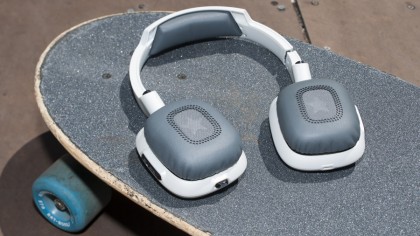TechRadar Verdict
For the gamer on the go, the Astro A38 is a powerful, petite set of cans – but if you're planning on staying sedentary, upgrade to the extraordinary Astro A40.
Pros
- +
Stylish, customizable design
- +
Active noise cancellation
- +
Long battery life
Cons
- -
No 3.5mm input
- -
Less comfy after long sessions
- -
Steep asking price
- -
No battery indicator
Why you can trust TechRadar
Bluetooth, by its very nature, is an unrestrictive platform. As a supplement to a standard 3.5mm connector, Bluetooth allows for freedom of movement unhindered by a 4-foot cord.
Take away the standard 3.5mm input, however, and a system that once used Bluetooth as a great extra, now depends on it as the only way to connect two devices. Case in point: Astro Gaming's first foray into the lifestyle headphone market, the Astro Gaming A38.
While it may not function as the best desktop headset, the A38 succeeds as a phone and tablet-focused set of cans. The idea here are headphones that come with you when you leave the house in the morning and be hung up when you get back to the auditory safety of your higher-end gaming headsets.
I can only imagine Astro did this intentionally for fear of competing with itself. Why create a device that can do both mobile and PC gaming if you currently own 80% of the high-end PC headset space with the wonderful (and expensive) Astro A40?

Design
Only a handful of "gaming" headphones allow you to walk outside the house and not have onlookers peg you with a '90s-era stereotype – nerd, dork, weirdo – or think you're being ironic. Thankfully, the Astro A38 is one of them.
The slim, all-plastic design comes in two colors: either pearl white with yellow bezel tags or a dark gray color with blue bezel tags. This may sound gross, but in the end it's often better to choose a darker color when face oil and sweat is involved.
While you're locked into one frame for the entirety of your A38s' life span, tags are customizable via Astro's website. If designing isn't your bag, you can always select some from the pre-made, often game-related designs.

On the other side of each earcup are plush, synthetic leather pads. They're fairly comfortable once you adjust them – the arms extend approximately one inch on each side – but aren't great for long-term listening. I couldn't keep the A38 cups on for longer than an hour or so, due to the heat and acute pressure.
The build quality is better than you'd expect from an all-plastic frame. But that doesn't mean you can be careless with them. Don't leave them around a crowded house outside their case. But, so long as you live by yourself, or have careful roommates, you can expect your $229 (about £140, AU$246) investment to be safe.
Three buttons are built into the earcups themselves, starting with power, which is used to sync the A38s with other devices. Joined by the usual volume control buttons, a multifunction button is used to stop, play and skip songs.

Two detractors from the A38 design are that the headphones lack both foldable joints and a physical battery indicator. Without foldable joints, you'll either have to wear them or stow them in the included, oversized case while on the move. It's a minor complaint, but one I can't help but feel defies Astro's "lifestyle product" descriptor.
Shipping a unit without placing a physical battery indicator is a real faux pas. I understand not wanting to overload the edge of the earcup, but removing the faceplate reveals an abundance of usable space. As it stands, the A38 uses audio tones to signal low battery, but you don't hear a peep for, say, the 50% or 75% marks. Bluetooth is capable of displaying battery information on your phone, though, so it's not a total loss.
That said, you likely won't hear the low-battery warning for some time due to the 15-plus hour rechargeable battery in the A38s. It lasted several days of use in a row before making it to the quarter-empty mark. I imagine that, because they were brand-new, this won't always be the case – I've never known a battery's capacity to hold out longer than the first few weeks – but expect similar results once you get yours out of the packaging.
Nick Pino is Managing Editor, TV and AV for TechRadar's sister site, Tom's Guide. Previously, he was the Senior Editor of Home Entertainment at TechRadar, covering TVs, headphones, speakers, video games, VR and streaming devices. He's also written for GamesRadar+, Official Xbox Magazine, PC Gamer and other outlets over the last decade, and he has a degree in computer science he's not using if anyone wants it.

